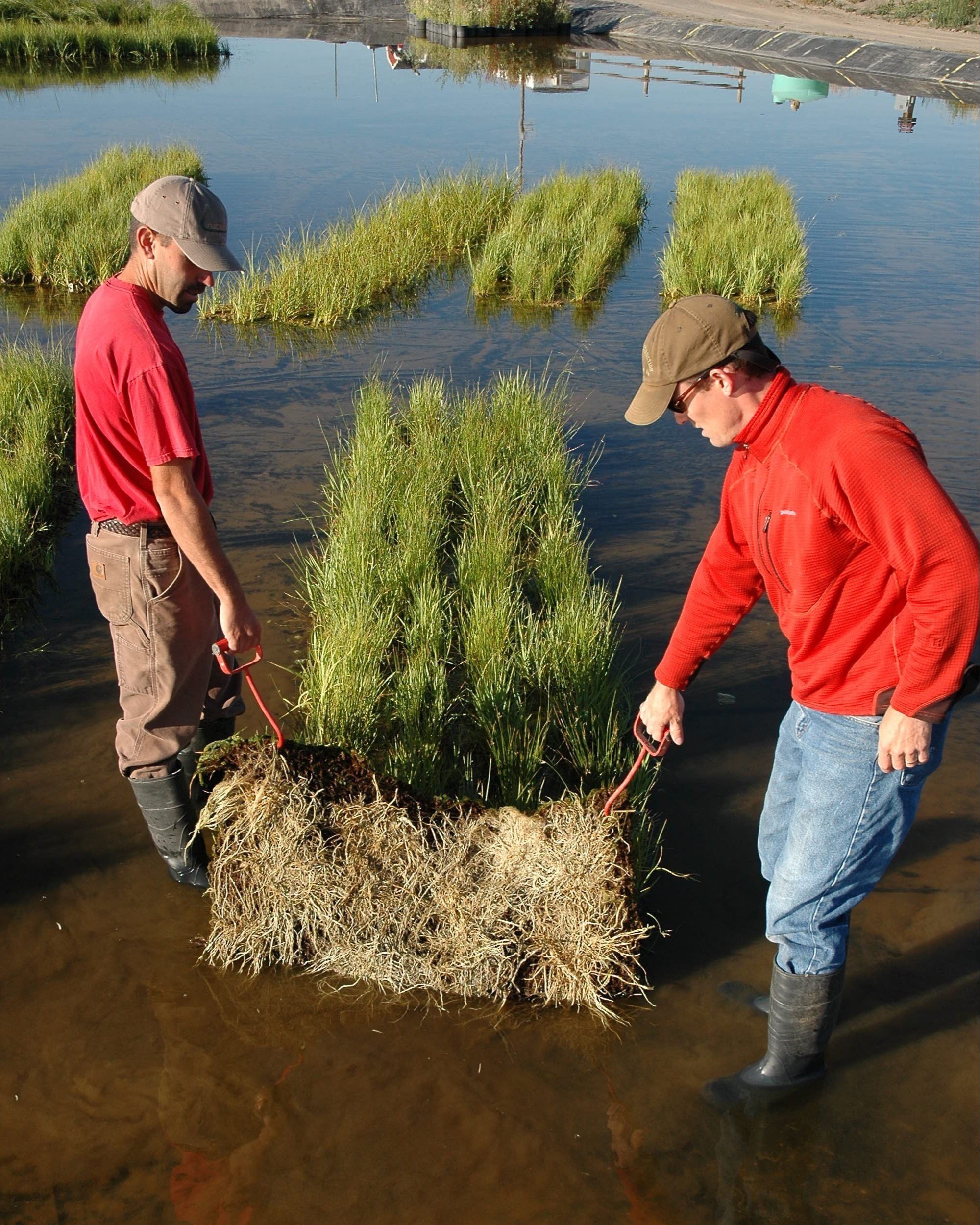What is Wetland Sod?
Erosion control matting with hydroponically grown native wetland plants all rolled into one.
Important Wetland Sod Links and Documents
Anatomy of a Mat
Wetland Sod Mats are pre-vegetated coir erosion control mats grown with native wetland plants to produce maximum root growth and provide immediate aesthetics, weed inhibition, and stabilization to erosion-prone shorelines and stream banks. North Fork Native Plants provides a variety of wetland sod mixes for stream restoration, shoreline and berm stabilization, wetland mitigation, storm water management, golf course water features, pond construction, and habitat enhancement, in Colorado, Idaho, Montana, Oregon, Utah, Washington, and Wyoming.
-
Having been grown out in a nursery under flooded or permanently saturated conditions, the plants are relatively mature and have well developed root systems and high shoot cover. This can greatly accelerate ecological and aesthetic results, reduce weed problems, and allow newly installed vegetation to tolerate less than ideal hydrologic conditions better than small individual plants.
-
Coir, or coconut fiber, mats function as an initial plant growth medium and provide excellent erosion control properties until the plants fully incorporate into the soil.
-
Wetland Sod mats are grown hydroponically promoting vigorous root growth, which facilitates extremely rapid establishment. In most cases wetland sod cannot be lifted from the soil surface after 2-5 weeks depending on species mix and climate.
3
1
2
Specifications
Coir Mat
Mat Material: Biodegradable, processed coconut fiber plugged with native wetland plants
Area: Wetland Sod units are 52 Sq. ft. per unit
Length: 16.2 ft. (5m) long,
Width: 3.2 ft. (1m) wide
Coir Mat Thickness: 3-4 inches
Coir Mat Weight– 2.7 kg/m2
Wetland Sod
Weight: 100 -150 lbs.
Plant height: 8-36” high depending on species.
Plant Coverage: Minimum of 50% root and 50% shoot coverage
Mat Readiness
To ensure Wetland Sod product readiness North Fork Native Plants uses a minimum growth specification that includes 50% shoot coverage on the top and 50% root coverage on the bottom at the time of delivery. This percentage pertains to the amount of each mat that is covered by plant and root material. Mat readiness specifications ensures product uniformity and the greatest chance for revegetation success.
Advantages
Native plant seed germination constraints, hydrologic fluctuations, erosion, weed invasion and wildlife damage can make wetland plant establishment a costly challenge. Wetland Sod addresses these problems on the front-end so that back-end results are more predictable and cost-effective. At installation, Wetland Sod already has abundant, healthy shoots, roots and a protective coir matrix to immediately stabilize soils, crowd out weeds and resist nuisance wildlife damage. In addition mature plants mean greater resiliency to hydrologic fluctuations.
-
The biodegradable coir mats are approximately 3" thick with a coir fill density of 6 pounds per square meter to provide immediate erosion control benefits. High plant survival and rapid spread rates ensure that plants take hold and provide long-term soil armoring.
-
Wetland Sod's "soil less" medium safeguards against unintentional introduction of noxious or invasive weeds often hidden in the soil seed banks of other plant material treatments. Following installation Wetland Sod's mature plant community suppresses weed seed germination and sequesters resources to inhibit competition from encroaching weeds.
-
Efficient sod-style installation can simplify and reduce labor costs for planting. Additionally, due to the relatively mature plants, Wetland Sod has less stringent requirements for topsoil or soil supplements.
-
Many projects wait 2-5 years to attain the aesthetic quality of Wetland Sod after just one growing season. Rapid wetland plant establishment ensures functional and aesthetically pleasing results.
Plant Mixes
North Fork Native Plants has experience growing many different wetland and riparian plant species for both custom projects and our speculative inventory. Field-testing consistently points to sedge and sedge/rush effectiveness for erosion control and fluctuating water level tolerance. We have grown various combinations of sedges and rushes, as well as monoculture bulrush mats that make up the vast majority of our mat production. These plants generally range from 12-24” in height with various green-colored stems and textures. All of these mixes are great cover and forage for many waterfowl species.
However, not all combinations are available speculatively on a year to year basis. Please see our Wetland Sod availability list or call us for more information.











